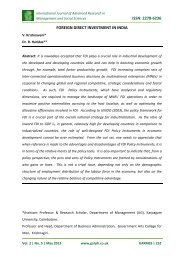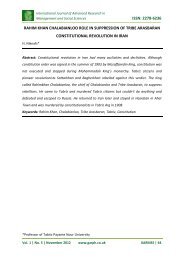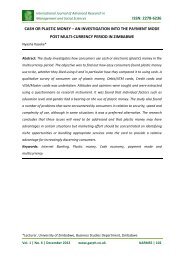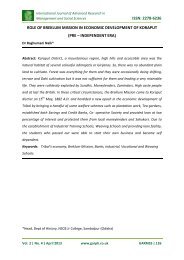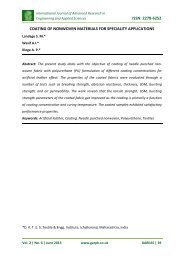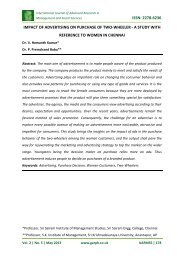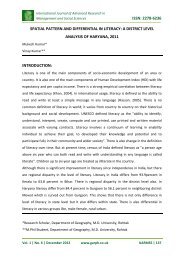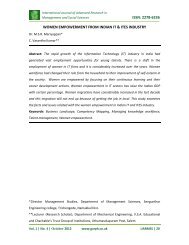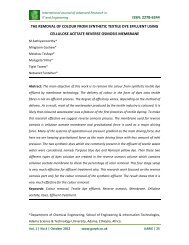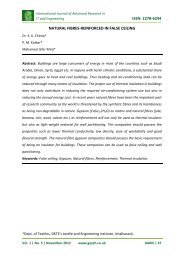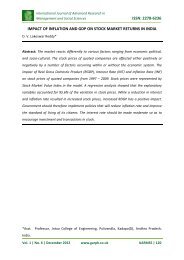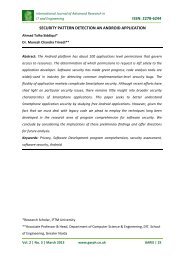issn: 2278-6236 small investor's behaviour on stock ... - Garph.co.uk
issn: 2278-6236 small investor's behaviour on stock ... - Garph.co.uk
issn: 2278-6236 small investor's behaviour on stock ... - Garph.co.uk
Create successful ePaper yourself
Turn your PDF publications into a flip-book with our unique Google optimized e-Paper software.
Internati<strong>on</strong>al Journal of Advanced Research in<br />
Management and Social Sciences ISSN: <str<strong>on</strong>g>2278</str<strong>on</strong>g>-<str<strong>on</strong>g>6236</str<strong>on</strong>g><br />
individual investor <str<strong>on</strong>g>behaviour</str<strong>on</strong>g> in <strong>stock</strong> market. Using univariate and multivariate analysis and<br />
found five major factors that affect the investment <str<strong>on</strong>g>behaviour</str<strong>on</strong>g> of individual investor in <strong>stock</strong><br />
market namely prudence and precauti<strong>on</strong>s attitude, c<strong>on</strong>servatism, under c<strong>on</strong>fidence,<br />
informati<strong>on</strong>al asymmetry and financial additi<strong>on</strong> . Finally, he c<strong>on</strong>cluded that these are the<br />
major psychological <strong>co</strong>mp<strong>on</strong>ents seem to be influencing individual investor’s trading<br />
<str<strong>on</strong>g>behaviour</str<strong>on</strong>g> in Indian <strong>stock</strong> market. In additi<strong>on</strong>, Al-Tamimi (2006) indentified the factors<br />
influencing the UAE investor <str<strong>on</strong>g>behaviour</str<strong>on</strong>g>. Using questi<strong>on</strong>naire found six factors were most<br />
influencing factors <strong>on</strong> the UAE investor <str<strong>on</strong>g>behaviour</str<strong>on</strong>g> namely expected <strong>co</strong>rporate earnings, get<br />
rich quick, <strong>stock</strong> marketability past performance of the firm’s <strong>stock</strong>, government holdings<br />
and the creati<strong>on</strong> of the organised financial markets. The most influencing factors include<br />
<strong>co</strong>rporate earnings; get rich quick, past performance of the <strong>stock</strong>. Kannadhasan (2006)<br />
examined the factors that influence the <str<strong>on</strong>g>small</str<strong>on</strong>g> investor’s decisi<strong>on</strong> in investing. The decisi<strong>on</strong><br />
of the <str<strong>on</strong>g>small</str<strong>on</strong>g> investors are based <strong>on</strong> various dependent variables viz., Gender, age, marital<br />
status, educati<strong>on</strong>al level, in<strong>co</strong>me level, awareness, preference and risk bearing capacity.<br />
Mittal and Vyas (2007) have investigated how investment choices have been affected by the<br />
demographics of the investors. Such knowledge would be highly useful to the financial<br />
advisors as it would help them advise their clients regarding investments which are<br />
appropriate with respect to their demographic profile. The salaried class people preferred to<br />
invest their m<strong>on</strong>ey in equities and mutual funds while business classes have shown an<br />
inclinati<strong>on</strong> to invest their m<strong>on</strong>ey in debenture/b<strong>on</strong>ds and real estate or bulli<strong>on</strong>s. Ajmi (2008)<br />
used a questi<strong>on</strong>naire to know determinants of risk tolerance of individual investors and<br />
<strong>co</strong>llected resp<strong>on</strong>ses from 1500 resp<strong>on</strong>dents. He c<strong>on</strong>cluded that the men are less risk averse<br />
than women, less educated investors are less likely to take risk and age factor is also<br />
important in risk tolerance and also investors are more risk tolerance than the less wealthy<br />
investors. Maditinos et al. (2007) in his study stated that individual investors, while making<br />
investment decisi<strong>on</strong>, prefer to think more about the media, newspapers and noise in<br />
market, despite this, professi<strong>on</strong>al investor would rather c<strong>on</strong>centrate more <strong>on</strong> technical and<br />
fundamental analysis and less <strong>on</strong> portfolio analysis. In additi<strong>on</strong>, their evidence describe that<br />
all kind of investors ac<strong>co</strong>rding to ac<strong>co</strong>unting instruments, first look at the earnings (P/E) as<br />
their first priority and c<strong>on</strong>sider earnings per share (EPS) as their sec<strong>on</strong>d priority, later pay<br />
attenti<strong>on</strong> to the net operating profit after taxes (NOPAT) as their third priority, and finally,<br />
Vol. 1 | No. 2 | August 2012 www.garph.<strong>co</strong>.<strong>uk</strong> IJARMSS | 65




